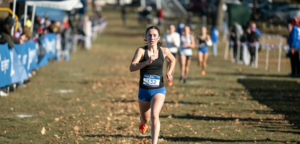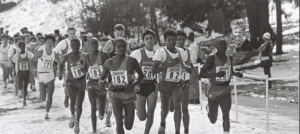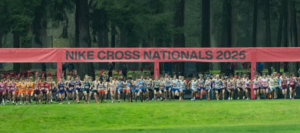For many high schoolers here in New Hampshire this week marks either a mandated week off, or the start of their summer training for the upcoming cross country season, that in eleven short weeks will be upon us. It’s a common comment among cross country coaches that cross country is a summer sport that simply plays out in the fall, meaning the key to success lies firmly in the concept of summer training. However the power of maintaining a summer running program, namely running consistently over the extent of the summer is often lost on those looking to run cross country in the fall.

On big cross country programs at the college level, the summer often means an opportunity to take one’s mileage to the next level. In the better programs the athletes will run their highest volume during the summer, then tone it down a bit when “in season.” This is often not the case for the high school runner. Other opportunities, heat and humidity, lack of structure, difficulty in getting others to go out with you all play a role in getting good mileage in. However if improving from last year is priority #1, the least complicated and sure fire way to do so is to run consistently.
Notice I said least complicated, not easy. All those above mentioned activities which become more readily available during the summer along with all the hurdles are real factors, but if you can commit to running consistently over the next eleven weeks, I can guarantee that as long as you can do so and remain healthy, you will run better in the coming season than you did last year. So in a way, once committed, the rest becomes easy.
I want to stress that the simplest way to get better is to simply run a bit more than you have before. If your highest mileage in the past was 30 miles a week, work up to 40. If it was 40, work up to 50. While I’ve had some kids doing as much as 60, they were few and far between and they had already committed a summer or two to consistent running. And they only did so during the last week or so. Jumping from 30 miles a week to 60 miles a week could also ensure you’re injured before you get the opportunity to see what your new fitness can do.
Additionally, we’ve always done everything by time, not distance specifically. Obviously if you know your average pace you can estimate your distance and almost everyone running with a watch has it calculate distance. However we never chased a particular distance, as when you really get right down to it, time on feet is more important than exactly how far you ran. Obviously if you run for more time and still know your average pace, you will have run more distance as well. But chasing distance “goals” doesn’t get you anywhere further than simply going by time and in my mind it’s safer. And safer means healthier.

While on the topic of distance, I also feel the summer is a great time to stretch the concept of the long run. I learned myself that getting out beyond the hour mark, and I like 75 minutes or more, can pay big dividends in your capacity to run at a higher rate of speed for a longer period of time. One winter as a young father I ran during the week when I could but ran half my mileage on Saturday and Sunday, when my daughters were taking their naps. I’d run up to two hours one day and then an hour+ on the other. The next spring, with no speedwork at all I was able to match my 5K race time from the fall after a summer of training. There are a number of reasons a exercise physiologist could give regarding burning fat vs carbs, energy utilization, running economy, etc. but just know having that long run under your belt can do wonders for your race pace work.
Not to mention extending your long run can allow for some great exploration. Let’s face it, during the season you are confined by the workouts that you’re running and the location of practice and the whims of the coach. Most coaches I know try to mitigate the potential for injury, often restricting the types of experiences you might have untethered to a training program. Maybe you have a friend that lives the right distance away that you could run to. Or maybe run to an ice cream shop or a swimming hole. Maybe just go explore some local or even nonlocal trails. You might just find that you enjoy running in ways that are not part of high school cross country or track and field, and that would be a good thing.

And this leads me to the concept of workouts. I never have nor do I believe that athletes should be running workouts during the summer. The object of the summer is simply to get aerobically fit, ready to take on the workouts that will come in the fall during the season. I’ve seen athletes (not mine) looking to take the next step, turning inward and crushing workouts during the summer. You can usually tell these individuals by their prolific summer racing, testing to see if the newfound speed has manifested itself over the 5K distance. In almost all cases these athletes end up burnt out by the end of the season and are non-factors when it matters the most. The body can only stand “building” workouts for a period of time before getting overstressed. I’ve heard 16 and 20 weeks thrown out as relative numbers on this, which means if correct, the decline will begin to happen mid season or right at the end. No one wants to be running on fumes leading into the State championships.
Which then leads me to what workouts can you do, if you want, that won’t have a negative effect on the fall season? While I’ve never put any of these in our summer programming, I do recognize that it feels good to run hard every now and then. So here are two options for someone that wants to do something but recognizes that maybe what I’m preaching is correct.
First off is the negative split run. We use these as tempo workouts during the season, and I like them because there is some safety built in that you wouldn’t get with a track workout. The concept is that you pick a time you want to run (say 50 minutes.) You go out and run half that time as an easy run, then turn around and picking up the pace to ensure you’re back before the specified time is up. This means for the second half of the run you are conscious of running smoothly and more upbeat, doing so while you’ve already got some minutes under you to tier you out.

The other workout is hills. Using hill repeats or a hilly fartlek run is a great way to work on your strength and speed, without digging yourself into a hole that might be hard to get out of. Vary the distance, vary the inclination, vary the intensity and you’ll be on your way to being stronger and likely faster as good coaches recognize that hills are speed in disguise, and come with a lesser likelihood of getting injured. Don’t do more than one of each of these a week and you’ll be making real progress.
You do these things, run consistent mileage, a little more than you’ve done before, take your long run beyond the hour mark (and beyond), and stay away from workouts that might get you injured, and you are definitely on your way to a PR in the fall. Do this a few years in a row and who knows, a Divisional All Star recognition might be in your future. Regardless, a PR is almost guaranteed, and the path to success is easy to follow, you just need to follow it. So while easy isn’t exactly easy, it’s a well beaten path that can be so easy to ignore. So don’t. Be good to be good.
I’ll see you out there.











